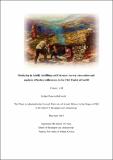| dc.description.abstract | Transhumance, called booleying in Ireland, is a practice found in many parts of Europe that involves the movement of livestock and their keepers from lowland, permanent settlements to summer pasture, usually in the uplands, where they remain generally from May to October. It was once an important part of the Irish pastoral economy but lack of research means that it is little understood.
The study area chosen for the thesis is the Civil Parish of Achill, which includes Achill Island, Achillbeg Island and the Corraun Peninsula in Co. Mayo in the west of Ireland. The principal aim of this thesis is to try to understand the phenomenon of booleying in the Civil Parish of Achill through time. A cross-disciplinary approach is taken in this work, using the combined evidence from fieldwork, excavation, architectural survey, the historical sources, antiquarian accounts, cartography, the pictorial evidence, place-name analysis and folklore to answer this question.
It is shown in the thesis that transhumance was a practice that benefited both man and beast, as the removal of livestock in spring or early summer helped to protect crops and grass for use as winterage at the permanent settlement from the depredations of livestock, while the change of pasture maintained the health of livestock and enabled larger herds to be kept. The social aspects of booleying in the study area were also examined and the combined archaeological, historical and folklore evidence suggests that the nearest modern equivalent experience to the practice is akin to modern camping. It is argued that booleying was common in the field area until the mid-nineteenth century and then declined after that, partly because of the availability of seasonal work in Scotland and England. | en_US |


